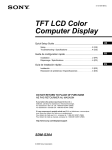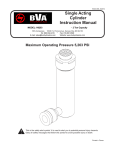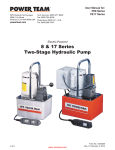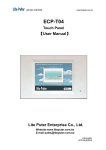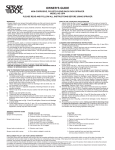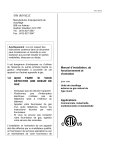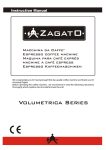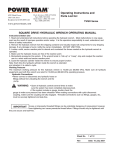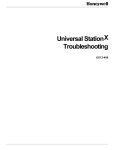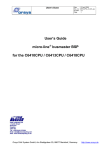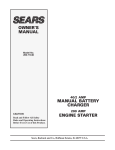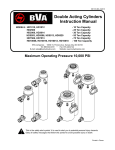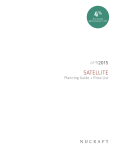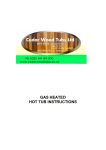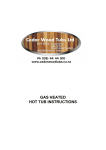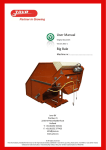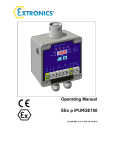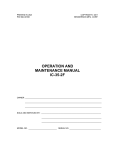Download User Manual - Hydraulic Cylinders
Transcript
User Manual for: EP18 Series EP211 Series Electric-Powered EP18 & EP211 Series Two-Stage Hydraulic Pump Rev. 0 May 2014 Table of Contents Description. . . . . . . . . . . . . . . . . . . . . . . . . . . . . . . . . . . . . . . . . . . . . . . . . . . . . . . . 2 PE18 / 211 Series Electric/Hydraulic Pumps . . . . . . . . . . . . . . . . . . . . . . . . . . . 2 Control Valves. . . . . . . . . . . . . . . . . . . . . . . . . . . . . . . . . . . . . . . . . . . . . . . . . . . . . .3 Safety Symbols and Definitions. . . . . . . . . . . . . . . . . . . . . . . . . . . . . . . . . . . . . . . . . .5 Safety Precautions. . . . . . . . . . . . . . . . . . . . . . . . . . . . . . . . . . . . . . . . . . . . . . . . . . .5 Initial Setup. . . . . . . . . . . . . . . . . . . . . . . . . . . . . . . . . . . . . . . . . . . . . . . . . . . . . . . .9 Operating Instructions. . . . . . . . . . . . . . . . . . . . . . . . . . . . . . . . . . . . . . . . . . . . . . . .12 Performance Specifications. . . . . . .. . . . . . . . . . . . . . . . . . . . . . . . . . . . . . . . . . . . . .14 General Maintenance. . . . . . . . . . . . . . . . . . . . . . . . . . . . . . . . . . . . . . . . . . . . . . .. .15 Troubleshooting Guide. . . . . . . . . . . . . . . . . . . . . . . . . . . . . . . . . . . . . . . . . . . . . . ..18 Page 2 Description The EP18 series hydraulic pumps are designed to have a maximum of 690 bar (10,000 psi) at a flow rate of 260 cc/min (16 cu. in/min). A pump can be valved for use with either single- or double-acting cylinders. The EP211 series pump all the same features as the EP18-series. The EP211series is equipped with a 1.12 kW (½ HP) 2,880 RPM electric motor where the EP18-series is equipped with a 0.37 kW (½ HP) 2860 RPM electric motor. All pumps come fully assembled, less fluid, and ready for work. EP18 / 211-Series Electric / Hydraulic Pumps The 17 series uses an induction motor. Refer to the Performance section of this manual for motor ratings. Electric Motor The EP18-series pumps are equipped with 0.37 kW (1/2 hp), 2860 rpm, single-phase, Brushless, induction motor; 3M remote control cord. Low amperage draw; small generators and low amperage circuits can be used as power source. Extremely quiet noise level (67-81 dBA). The EP211-series pumps are equipped with 1.12 kW, 2880 rpm, single-phase, Brushless, induction motor. Figure 1. EP18D Figure 2. EP211D Page 3 Control Valves Max. Capacity: 690 Bar (10,000 PSI) Valve Function Use with Valve No. Cylinder Type Single- & BP423 4-way,3double- position, pump mounted manual acting EP18D EP211D detented Diagrams Valve Function Use with Cylinder Type Single acting EP18S EP211S Valve No. B1014 2-way,2position,pump mounted manual detented Diagrams Valve Function Use with Cylinder Type Single acting EP18SS EP211SS Valve No. 18-471-217 3way,2-position, Pump mounted solenoid operated, normally closed Diagrams Table 1. Pump Configurations Page 4 Safety Symbols and Definitions The safety signal word designates the degree or level of hazard seriousness. DANGER: Indicates an imminently hazardous situation which, if not avoided, will result in death or serious injury. WARNING: Indicates a potentially hazardous situation which, if not avoided, could result in death or serious injury. CAUTION: Indicates a potentially hazardous situation which, if not avoided, may result in minor or moderate injury. CAUTION: Used without the safety alert symbol indicates a potentially hazardous situation which, if not avoided, may result in property damage. IMPORTANT: Important is used when action or lack of action can cause equipment failure, either immediate or over a long period of time. Safety Precautions WARNING: • The following procedures must be performed by qualified, trained personnel who are familiar with this equipment. Operators must read and understand all safety precautions and operating instructions included with the pump. If the operator cannot read these instructions, operating instructions and safety precautions must be read and discussed in the operator's native language. • These products are designed for general use in normal environments. These products are not designed for lifting and moving people, agri-food machinery, certain types of mobile machinery, or in special work environments such as: explosive, flammable, or corrosive. Only the user can decide the suitability of this product in these conditions or extreme environments. Power Team will supply information necessary to help make these decisions. Consult your nearest Authorized Dealersy. • Safety glasses must be worn at all time by the operator and anyone within sight of the unit. Additional personal protection equipment may include: face shield, goggles, gloves, apron, hard hat, safety shoes, and hearing protection. • The owner of this tool must ensure that safety-related decals are installed, maintained, and replaced if they become hard to read. • Shut OFF the motor before opening any connections in the system. • The guide cannot cover every hazard or situation so always do the job with SAFETY FIRST. Pump WARNING: • Do not exceed the hydraulic pressure rating noted on the pump nameplate or tamper with the internal high pressure relief valve. Creating pressure beyond rated capacities can result in personal injury. • Retract the system before adding fluid to prevent overfilling the pump reservoir. An overfill can cause personal injury due to excess reservoir pressure created when cylinders are retracted. • The load must be under operator control at all times. Page 5 Safety Precautions continued • Do not connect pump to hydraulic system powered by another pump. Electric Motor WARNING: • Electrical work must be performed and tested by a qualified electrician per local directives and standards. • Disconnect the pump from the power supply and relieve pressure before removing the motor case cover or performing maintenance or repair. • Check the total amperage draw for the electrical circuit you will be using. For example: Do not connect a pump that may draw 25 amps to a 20 amp fused electrical circuit. • Never use an ungrounded power supply with this unit. • Changing the voltage is an involved and, if incorrectly performed, hazardous procedure. Consult the manufacturer for specific information before attempting rewiring. • Wire pump motors for counterclockwise rotation when viewed from the shaft end of the motor. • Do not attempt to increase the power line capacity by replacing a fuse with another fuse of higher value. Overheating the power line may result in fire. • Exposing electric pumps to rain or water could result in an electrical hazard. • Avoid conditions that can cause damage to the power cord, such as abrasion, crushing, sharp cutting edges, or corrosive environment. Damage to the power cord can cause an electrical hazard. Hoses WARNING: • Before operating the pump, tighten all hose connections using the correct tools. Do not overtighten. Connections should be only secure and leak-free. Overtightening can cause premature thread failure or high pressure fittings to split at pressures lower than their rated capacities. • Should a hydraulic hose rupture, burst, or need to be disconnected, immediately shut off the pump and shift the control valve twice to release pressure. Never attempt to grasp a leaking hose under pressure with your hands. The force of escaping hydraulic fluid could cause serious injury. • Do not subject the hose to potential hazard, such as fire, sharp surfaces, heavy impact, or extreme heat or cold. Do not allow the hose to kink, twist, curl, or bend so tightly that the fluid flow within the hose is blocked or reduced. Periodically inspect the hose for wear, because any of these conditions can damage the hose and possibly result in personal injury. • Do not use the hose to move attached equipment. Stress can damage the hose and possibly cause personal injury. • Hose material and coupler seals must be compatible with the hydraulic fluid used. Hoses also must not come in contact with corrosive material such as creosoteimpregnated objects and some paints. Consult the manufacturer before painting a hose. Never paint the couplers. Hose deterioration due to corrosive materials may result in personal injury. Page 6 Safety Precautions continued • Avoid straight line tubing connections in short runs. Straight line runs do not provide for expansion and contraction due to pressure and/or temperature changes. • Eliminate stress in the tube lines. Long tubing runs should be supported by brackets or clips. Tubes through bulkheads must have bulkhead fittings. This makes easy removal possible and helps support the tubing. • Carefully inspect all hoses and fittings prior to use. Before each use, check entire hose for cuts, leaks, abrasion or bulging of cover, or damage or movement of couplings. If any of these conditions exist, replace the hose immediately. NEVER attempt to repair the hose. Cylinder DANGER: • Do not exceed rated capacities of the cylinders. Excess pressure may result in personal injury. • Avoid off-center loads that could damage the cylinder and/or cause loss of the load. • Read and understand all safety and warning decals and instructions for devices attached. • Inspect each cylinder and coupler before each shift or usage to prevent unsafe conditions from developing. • Do not use cylinders if they are damaged, altered or in poor condition. • Do not use cylinders with bent or damaged couplers or damaged port threads. • Under certain conditions, the use of an extension with a hydraulic cylinder may not be advisable and could present a dangerous condition. • Avoid pinch points or crush points that can be created by the load or parts of the cylinder. • To help prevent material fatigue if the cylinder is to be used in a continuous application, the load should not exceed 85% of the rated capacity or stroke. • Cylinder must be on a stable base which is able to support the load while pushing or lifting. • To help prevent personal injury, use shims, friction material or constraints to prevent slippage of the base or load. • Do not set poorly-balanced or off-center loads on a cylinder. • The load can tip or the cylinder can “kick out” and cause personal injury. • Do not use the locking collar on a threaded piston as a stop. The threads may shear resulting in loss of the load. • If this component is used to lift or lower loads, be certain that the load is under operator control at all times and that others are clear of the load. • Do not drop the load. • As the load is lifted, use blocking and cribbing to guard against a falling load. • To help prevent personal injury, do not allow personnel to go under or work on a load before it is properly cribbed or blocked. All personnel must be clear of the load before lowering. Page 7 Safety Precautions continued • Never use extreme heat to disassemble a hydraulic cylinder or ram. Metal fatigue and/ or seal damage will result and can lead to unsafe operating conditions. IMPORTANT • Keep the cylinder clean at all times. • While at a job site, when the cylinder is not in use, keep the piston rod fully retracted and upside down. • Always use protective covers on disconnected quick couplers. • When mounting cylinders or rams using the internal piston rod threads, collar threads, threaded tie rods or base mounting holes, the threads must be fully engaged. Always use SAE grade 8 or better fasteners when attaching components to cylinders or rams and tighten securely. • Limiting the stroke and pressure on all cylinders will prolong their life. Page 8 Initial Setup 1. Remove all packing materials from the assembled unit. 2. Inspect the unit upon arrival. The carrier, not the manufacturer, is responsible for any damage resulting from shipment. Filling the Pump Reservoir Most pumps are shipped without hydraulic fluid in the reservoir. Hydraulic fluid may have been shipped in a separate container, but if hydraulic fluid is needed, use only approved Powerram hydraulic fluid rated at AW 46 47 cSt @ 38°C (215 SUS @ 100°F). If low temperature requirements are needed, use hydraulic fluid 5.1 cSt @ 100°C (451 cSt @ -40°C). 1. Clean the area around the filler cap to remove debris. Debris in the hydraulic fluid can damage the polished surfaces and precision-fit components of this pump. 2. Remove the filler cap and insert a clean funnel with a filter. 3. Fill the reservoir with hydraulic fluid to 8 L and 11 L from the cover plate. 4. Replace the filler cap. Verify the breather-hole is open, if applicable. NOTE: If hydraulic fluid foaming becomes a problem, reduce the hydraulic fluid level to 2" below the cover plate. Hydraulic Connections 1. Clean the areas around the fluid ports of the pump and cylinders. 2. Inspect all threads and fittings for signs of wear or damage, replace as needed. 3. Clean all hose ends, couplers or union ends. 4. Remove the thread protectors from the hydraulic fluid outlets. 5. Connect the hose assembly to the hydraulic fluid outlet, and couple the hose to the cylinder. CAUTION: To prevent personal injury from leaking hydraulic fluid, seal all hydraulic connections with a high-quality, non-hardening, pipe thread sealant. IMPORTANT: Sealant tape or non hardening sealer tape can be used to seal hydraulic connections if only one layer of tape is used. Apply tape carefully, two threads back, to prevent it from being pinched by the coupler and broken off inside the system. Loose pieces of sealant could travel through the system and obstruct the flow of fluid or cause jamming of precision-fit parts. Electric Motor Operation Motor voltages are not changeable. They are: 12 VDC - 11-14 VDC 120 VAC - 90-130 VAC 50/60 Hz 220 VAC - 190-240 VAC 50/60 Hz 1. Verify the valve is in the neutral or hold position. 2. Connect the motor to a power supply. Caution: • The correct voltage is required for the pump to operate. Verify the voltage rating on the pump motor name plate matches the outlet or power source you are using. Low voltage may cause: an overheated motor; a motor that fails to start under load; motor surging when trying to Page 9 Initial Setup continued start; or a stalled motor before maximum pressure is reached. • Check the voltage at the motor with the pump running at full pressure. • Never run the motor on long, light gauge extension cords. Refer to Table 2. Minimum Recommended Gauge Table. 3. Start the pump and shift as required. 4. Turn off the pump when not in use. Electrical Cord Size AWG (mm2) 3.2 Volt Drop Length of Electrical Cord AMPS AT Maximum Hyd.Pressure AWG mm2 0-8 m 8-15m 15-30 m 30-46 m 0-25 ft 25-50 ft 50-100 ft 100-150 ft 6 0.75 1 1.5 2.5 18 16 14 12 10 0.75 1.5 2.5 4 18 14 12 10 14 1 2.5 4 6 16 12 10 8 18 1.5 2.5 6 6 14 12 8 8 22 1.5 4 6 10 14 10 8 6 26 2.5 4 6 10 12 10 8 6 30 2.5 4 10 16 12 10 6 4 Table 2. Minimum Recommended Gauge Table Bleeding Air from the System After all connections are made, the hydraulic system must be bled of any trapped air. Refer to Figure 3. With no load on the system and the pump vented and positioned higher than the hydraulic device, cycle the system several times. If you are in doubt about venting your pump, read the operating instructions for your pump. Check the reservoir fluid level and fill to proper level with the hydraulic fluid as necessary. If there is a problem contact the authorized dealers. Figure 3. System Bleeding IMPORTANT: Some spring return cylinders or rams have a cavity in the rod which forms an air pocket. This type of cylinder or ram should be bled when positioned upside down or lying on its side with the port facing upward. Page 10 Operating Instructions Bleeding Air from the System 1. Cycle the hydraulic system until operation is smooth and consistent. 2. Check the pump reservoir level. Add the hydraulic fluid as needed. Electric Motor Control Operation 1. Connect the power cord to an appropriate power source. 2. Place the motor control switch in the ON position. 3. Depending on system requirements: Refer to Figure 7. This remote will start and run the pump motor as long as the button is pressed. Switch will automatically return to OFF position when button is released and pump motor will turn off. Figure 7. Push Button Remote Motor Control Performance Specifications The information in the following charts can be used as a basis to determine if the system is performing as expected during operation. Amp Draw at Pump 690 Bar (10,000 PSI) (115V) RPM Amp Draw at dB A at Idle 690 Bar (10,000 PSI) (230V) and 690 Bar (10,000PSI) EP18 Series 2,860 9.6 4.8 67/81 EP211 Series 2,880 22.6 11.3 67/81 Table 3. Drive Unit Requirements Pump Max. Pressure Output Bar (PSI) Fluid Delivery** (cc./min. @) 0 Bar (0 PSI) 7 Bar (100 PSI) 50 Bar (700 PSI) 70 Bar (1,000 PSI) 345 Bar (5,000 PSI) 690 Bar (10,000 PSI) EP18 690 Bar 4200 2800 330 300 EP211 690 Bar 8200 7400 840 750 ** Typical delivery. Actual flow varies with field conditions. Table 4. Fluid Pressure Chart Page 11 General Maintenance WARNING: • Disconnect the unit from the power supply before performing maintenance or repair procedures. • Repairs and maintenance are to be performed in a dust-free area by a qualified technician. System Evaluation The components of your hydraulic system — cylinders, pumps, hoses, and couplings — all must be: • Rated for the same maximum operating pressure. • Correctly connected. • Compatible with the hydraulic fluid used. A system that does not meet these requirements can fail, possibly resulting in serious injury. If you are in doubt about the components of your hydraulic system, contact Powerram Technical Support. Inspection Keep a dated and signed inspection record of the equipment. An inspection checklist is available on request from your nearest Authorized Dealers. Before each use, the operator or other designated personnel should visually inspect for the following conditions: • Cracked or damaged cylinder. • Excessive wear, bending, damage, or insufficient thread engagement. • Leaking hydraulic fluid. • Scored or damaged piston rod. • Incorrectly functioning or damaged heads and caps. • Loose bolts or cap screws. • Damaged or incorrectly assembled accessory equipment. • Modified, welded, or altered equipment. • Bent or damaged couplers or port threads. Periodic cleaning WARNING: Contamination of the hydraulic fluid could cause the valve to malfunction. Loss of the load or personal injury could result. Establish a routine to keep the hydraulic system as free from debris as possible. • Seal unused couplers with dust covers. • Keep hose connections free of debris. Equipment attached to a cylinder must be kept clean. • Keep the breather-hole in the filler cap clean and unobstructed. • Use only Powerram hydraulic fluid. Replace hydraulic fluid as recommended, or sooner if the fluid becomes contaminated. Never exceed 300 hours of use between fluid changes. Hydraulic Fluid Level 1. Check the fluid level in the reservoir after each 10 hours of use. The fluid level should be 1.3-3.8 cm (0.5-1.5 in.) from the top of the fill hole when all cylinders are retracted. 2. Drain, flush, and refill the reservoir with an approved Powerram hydraulic fluid after every 300 hours of use. The frequency of fluid changes depends upon general working conditions, severity of use, the overall cleanliness and care given to the pump. Fluid should be changed more frequently when the system is not operated regularly indoors. Page 12 General Maintenance continued Adding Hydraulic Fluid To The Reservoir 1. Retract the cylinder(s) devices. 2. Disconnect the power supply. 3. Clean the entire area around the filler plug. 4. Remove the filler plug, and install a clean funnel with a filter. 5. Use only Powerram hydraulic fluid rated at AW 46 47 cSt @ 38°C (215 SUS @ 100°F). If low temperature requirements are needed, use hydraulic fluid 5.1 cSt @ 100°C (451 cSt @ -40°C) Sound Reduction - Electrically Powered Motor The electrically powered hydraulic pump operates in the 67-81 dBA range. If further sound reduction is desired, any of the following options will help reduce the sound level. 1. Install a pressure switch to automatically shut off the motor when maximum pressure is reached (holding cycle). 2. Contact Powerram Authorized Dealers support for products more suitable to your application. Hose Connections CAUTION: To prevent personal injury from leaking hydraulic fluid, seal all hydraulic connections with a high-quality, non-hardening, pipe thread sealant. IMPORTANT: Sealant tape or non-hardening sealer tape can be used to seal hydraulic connections if only one layer of tape is used. Apply tape carefully, two threads back, to prevent it from being pinched by the coupler and broken off inside the system. Loose pieces of sealant could travel through the system and obstruct the flow of fluid or cause jamming of precision-fit parts. Storage Store the unit in a dry, well-protected area where it will not be exposed to corrosive vapors, dust, or other harmful elements. If a unit has been stored for an extended period of time, it must be thoroughly inspected before it is used. Page 13 Troubleshooting Guide WARNING: • Repair work or troubleshooting must be performed by qualified personnel who are familiar with this equipment. • Disconnect the power supply before removing the electrical cover. Electrical work should be performed by a qualified electrician. • Check for system leaks by using a hand pump to apply pressure to the suspect area. Watch for leaking fluid and follow it back to its source. Never use your hand or other body parts to check for a possible leak. Notes: • For a detailed parts list or to locate a Powerram Authorized Hydraulic Service Center, contact your nearest Powerram Authorized Dealers. • Plug the outlet ports of the pump when checking for leakage to determine if the leakage is in the pump, in the cylinder, or in the tool. Problem Electric motor does not run. Pump is not delivering hydraulic fluid or delivers only enough hydraulic fluid to advance cylinder(s) partially or erratically. Cause Solution 1. Unit is not plugged in. 1. Plug in unit. 2. No voltage supply. 2. Check line voltage. 3. Broken lead wire or defective power cord plug 3. Replace defective parts. 4. Defective motor. 4. Replace or repair motor. 1. Hydraulic fluid level too low. 1. Fill reservoir to 1-1/2" below the cover plate, maximum. 2. Air in system. 3. Debris is in pump or filter is plugged. 2. Bleed the system. 4. Cold hydraulic fluid or hydraulic fluid is too heavy (hydraulic fluid is of a higher viscosity than necessary). 3. Pump filter should be cleaned and, if necessary, pump should be dismantled and all parts inspected and cleaned. 4. Change to lighter hydraulic fluid. 5. Readjust as needed. 5. Relief valve or low pressure unloading valve out of adjustment. 6. Sheared drive shaft key(s). 6. Replace. 7. Motor rotating in wrong direction. 7. Reverse rotation. Page 14 Troubleshooting Guide continued Problem Pump will not build full pressure. Cause 1. Faulty pressure gauge. 2. Check for external leakage. 3. Inspect the pump for internal leakage. 5. High pressure pump inlet or outlet ball checks in the pump are leaking. 1. Unloading pressure is too low. 2. Defective or oversize seat on utomatic valve. Electric motor cuts out. 1.Extension cord is too long and/ or not of sufficient gauge. 3. Overheated motor can trip circuit breaker in shop power panel. Cylinder(s) will not retract. Pump delivers excess hydraulic fluid pressure. 3. Same procedure as above but for leaks around the entire inner mechanism. If there are no visible leaks the low-to-high pressure ball check may be leaking. Remove all parts. Inspect the check body for any damage to the seat areas. Clean and reseat if necessary. Inspect the ball for damages and replace if necessary, then reassemble. 5. Reseat or replace valve head. 1. Increase unloading pressure per chart, sheet 3 of 4. 2. Replace ball and seat. 1. Replace. 2. Replace and repair. 2. Faulty motor. Foaming hydraulic fluid. 1. Calibrate gauge. 2. Seal any faulty pipe fittings with Pipe sealant. 4. Replace. 4. Sheared key(s). Automatic valve will not build full pressure Solution 1. Hydraulic fluid being splashed by counter weight. 3. Allow motor to cool, reset circuit breaker located in shop power panel. 1. Lower hydraulic fluid level to approximately 38 mm (1.5 inches) below the cover plate. 1. Check the cylinders for broken return springs and check couplers to ensure that they are completely coupled. Occasionally couplers have to be replaced because one check does not stay open in the coupled position. 1. Pressure gauge is not accurate. 1. Calibrate gauge. 2. Reset the relief valve. 2. Relief valve not properly set. 1. Check the system pressure; if the pressure is zero, the control valve is releasing pressure and the problem may be in the cylinder(s), mechanical linkage connected to cylinder(s), or quickdisconnect couplings. Page 15 Troubleshooting Guide continued Problem Automatic valve will not release pressure. Cause Solution 1. Sticking piston. 1. Remove, clean and polish. 2. High pressure hydraulic fluid is leaking past the low-to-high pressure check. This hydraulic fluid leaks back to the piston in the automatic valve, keeping the piston closed. 2. Seat the ball check. Inspect and replace any faulty components. Page 16


















